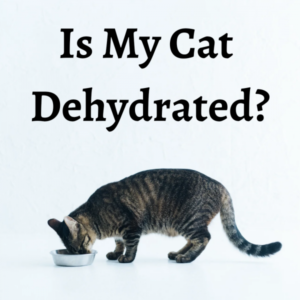
Have you ever suspected your cat of being dehydrated because you felt they weren’t getting enough water to drink or because they didn’t seem quite themselves?
The majority of cats experience this issue, especially sick cats.
Extremely young and old cats are both more vulnerable to the effects of fluid loss. Middle-aged cats in generally good health can often withstand the effects of mild dehydration better than, say, an elderly cat with many health issues.
What you need to know about cat dehydration, including the symptoms, causes, what to do, and appropriate treatments, is provided here.
What Does Cat Dehydration Mean?
Cats become dehydrated when they are not replacing the fluids they are losing through drinking. This may occur occasionally only because the person isn’t feeling well and isn’t drinking much, but it may also be the result of an illness like vomiting or diarrhoea.
Cats typically endure changes (generally losses) in multiple electrolytes, including sodium, calcium, and potassium, when they get dehydrated. For a cat’s organs and tissues to continue to operate correctly, appropriate hydration and electrolyte balance are crucial. Even death can result from severe dehydration.
Cat and Kitten Dehydration Symptoms
Dehydration symptoms can be either subtle or extremely complex.
When a cat is dehydrated, they typically don’t feel well, which makes it obvious that they aren’t drinking the recommended amounts of fluids and frequently aren’t eating adequately. They won’t be energetic and won’t be acting in the way you might expect them to act normally. Some cats may have sunken eyes, and occasionally they may pant, appear weak, or even collapse if they are severely dehydrated.
Step 1 : Examine their gums.
You can gently lift your cat’s lip and feel their gums to see whether they’re dehydrated. They ought to be slimy and wet like real gums. Your cat is probably dehydrated if they feel dry to the touch and appear a little sticky.
Step 2 : Skin-Pinch Test
The skin pinch test is another widely used technique to determine moisture levels in animals. Only young, healthy animals with elastic skin can pass this test; older cats or cats who have chronic illnesses find this test less helpful.
But if you lightly pull (or “pinch”) the skin between your cat’s shoulder blades and then release your grip, the skin ought to immediately snap back into place. Dehydration may also be indicated if the skin between your cat’s shoulder blades slowly returns to its original place as opposed to snapping.
Dehydration in Cats and Kittens: Its Causes
Cats can get dehydrated for a variety of reasons, but they all stem from the fact that they are losing fluids more quickly than they are consuming them.
All cats continuously lose fluids throughout the day; even breathing causes vital fluids to evaporate, and a significant amount is lost each time a cat urinates. Water is necessary for all of the body’s fundamental functions, so maintaining sufficient hydration is essential for regaining equilibrium.
Any disturbance of this equilibrium is likely to result in dehydration:
- Not consuming any food or liquids at all: Anything that makes your cat eat or drink improperly is one of the more frequent causes of dehydration. Dehydration occurs quickly if your cat is still using fluids but not consuming them.
- Diarrhoea and vomiting: In such circumstances, your cat is rapidly losing fluids and might not feel well enough to drink or eat to replenish them.
- Kidney illness with diabetes: These two conditions both affect cats and result in increased water loss, which can quickly lead to dehydration.
- Fever or a serious injury: Both of these frequently lead to a cat losing water.
- Dry air and hot weather: Dehydration may result from either of these over time.
Typically, the severity of dehydration varies depending on the underlying cause, with mild conditions producing milder dehydration.
How to Treat a Dehydrated Cat?
Call your veterinarian right away if you suspect that your cat may be dehydrated. It can be challenging to establish the extent of the dehydration, but your veterinarian will be better qualified to do so as well as to identify the underlying reason.
NEVER try to force water on your cat or use a dropper to administer food or water. The fluids could inadvertently be injected into the lungs, which would cause life-threatening pneumonia.
If you think your cat may be dehydrated, you should give them canned food, tuna intended for human consumption, water, and Pedialyte. Wait until you can get to the vet clinic if your cat won’t drink the fluids on its own.
Treatment for Cat Dehydration
Any cat who is dehydrated should have a thorough examination by a veterinarian to search for symptoms of a larger illness and any underlying disorders that might have contributed to the dehydration.
To ascertain the degree of dehydration and the underlying reason, your veterinarian will typically also want to perform certain laboratory tests, including blood and urine. Depending on the circumstances, more testing can be advised.
Treatment options differ as well. Fluids administered subcutaneously (also known as subcutaneous fluids) are frequently used to treat a variety of illnesses, including mild dehydration, and are typically carried out on your cat as an outpatient treatment.
Poorer, more delicate, or more dehydrated animals could require hospitalisation in order to have an IV catheter implanted so that fluids can be administered directly into the bloodstream. Animals who are severely dehydrated may need several days to rehydrate.

